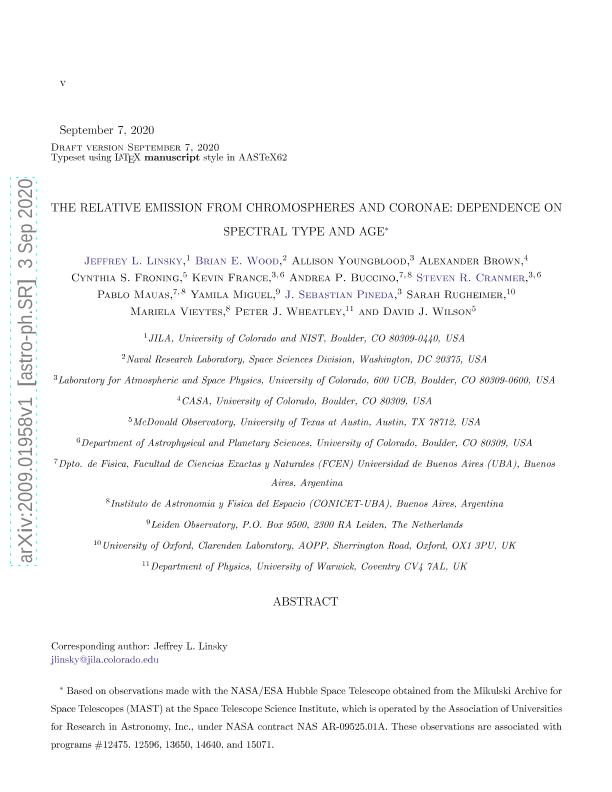Artículo
The relative emission from chromospheres and coronae: Dependence on spectral type and age
Linsky, Jeffrey L.; Wood, Brian E.; Youngblood, Allison; Brown, Alexander; Froning, Cynthia S.; France, Kevin; Buccino, Andrea Paola ; Cranmer, Steven R.; Mauas, Pablo Jacobo David
; Cranmer, Steven R.; Mauas, Pablo Jacobo David ; Miguel, Yamila
; Miguel, Yamila ; Sebastian Pineda, J.; Rugheimer, Sarah; Vieytes, Mariela Cristina
; Sebastian Pineda, J.; Rugheimer, Sarah; Vieytes, Mariela Cristina ; Wheatley, Peter J.; Wilson, David J.
; Wheatley, Peter J.; Wilson, David J.
 ; Cranmer, Steven R.; Mauas, Pablo Jacobo David
; Cranmer, Steven R.; Mauas, Pablo Jacobo David ; Miguel, Yamila
; Miguel, Yamila ; Sebastian Pineda, J.; Rugheimer, Sarah; Vieytes, Mariela Cristina
; Sebastian Pineda, J.; Rugheimer, Sarah; Vieytes, Mariela Cristina ; Wheatley, Peter J.; Wilson, David J.
; Wheatley, Peter J.; Wilson, David J.
Fecha de publicación:
10/2020
Editorial:
IOP Publishing
Revista:
Astrophysical Journal
ISSN:
1538-4357
e-ISSN:
0004-637X
Idioma:
Inglés
Tipo de recurso:
Artículo publicado
Clasificación temática:
Resumen
Extreme-ultraviolet and X-ray emission from stellar coronae drives mass loss from exoplanet atmospheres, and ultraviolet emission from stellar chromospheres drives photochemistry in exoplanet atmospheres. Comparisons of the spectral energy distributions of host stars are, therefore, essential for understanding the evolution and habitability of exoplanets. The large number of stars observed with the MUSCLES, Mega-MUSCLES, and other recent Hubble Space Telescope observing programs has provided for the first time a large sample (79 stars) of reconstructed Lyα fluxes that we compare with X-ray fluxes to identify significant patterns in the relative emission from these two atmospheric regions as a function of stellar age and effective temperature. We find that as stars age on the main sequence, the emissions from their chromospheres and coronae follow a pattern in response to the amount of magnetic heating in these atmospheric layers. A single trend-line slope describes the pattern of X-ray versus Lyα emission for G and K dwarfs, but the different trend lines for M dwarf stars show that the Lyα fluxes of M stars are significantly smaller than those of warmer stars with the same X-ray flux. The X-ray and Lyα luminosities divided by the stellar bolometric luminosities show different patterns depending on stellar age. The L (Lyα)/L(bol) ratios increase smoothly to cooler stars of all ages, but the L(X)/L(bol) ratios show different trends. For older stars, the increase in coronal emission with decreasing Teff is much steeper than that of chromospheric emission. We suggest a fundamental link between atmospheric properties and trend lines relating coronal and chromospheric heating.
Palabras clave:
Ultraviolet sources
Archivos asociados
Licencia
Identificadores
Colecciones
Articulos(IAFE)
Articulos de INST.DE ASTRONOMIA Y FISICA DEL ESPACIO(I)
Articulos de INST.DE ASTRONOMIA Y FISICA DEL ESPACIO(I)
Citación
Linsky, Jeffrey L.; Wood, Brian E.; Youngblood, Allison; Brown, Alexander; Froning, Cynthia S.; et al.; The relative emission from chromospheres and coronae: Dependence on spectral type and age; IOP Publishing; Astrophysical Journal; 902; 1; 10-2020; 1-15
Compartir
Altmétricas



